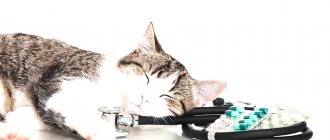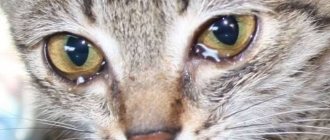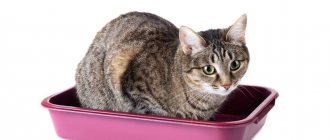If your cat is coughing, it is important to understand what happened to him. The symptom can indicate a variety of problems - from a foreign body getting into the mouth to an asthma attack. A veterinarian can make an accurate diagnosis, and the owner must pay attention to the accompanying signs. This will help to quickly identify the disease and prescribe the correct treatment to the animal.
Respiratory diseases
A common cold can easily provoke coughing, sneezing, swelling of the mucous membranes, and discharge of pus from the nasal passages and eyes. During this period, it is difficult for the pet to swallow, which is why he stops eating and even drinking. Inflamed airways, fortunately, are easy to treat.
Read also: Why does the cylinder head gasket burn out?
The disease is eliminated with the help of antiviral, antibacterial medications, as well as expectorants or antitussives, which are prescribed depending on the type of cough. To restore and subsequently strengthen the animal’s immunity, the veterinarian prescribes a vitamin complex. As a preventive measure , you should take your cat for vaccination , which will reduce the risk of a serious disease.
How to help your pet
First, calm down yourself and try to calm your pet. Frankly speaking, at home it is only possible to alleviate the condition of a sick animal.
- To do this, ventilate the room, humidify the air, but avoid drafts, so as not to harm the already sick animal.
- You can inhale warm, moist air by running hot water into the bathroom, and then leave the cat in the bathroom for a while.
Cats are very sensitive to emotions, so be sure to caress your pet, talk to him in a calm, confident tone, then the animal will understand that the owner will help him, this will alleviate the patient’s condition.
Under no circumstances should you give medications before going to the veterinary clinic; this is important for making an accurate diagnosis; besides, not knowing the exact cause of the cough can only harm the animal.
Main symptoms
It is very easy to identify a cough in your pet. The cat unnaturally stretches its neck forward, tilts its head, and opens its mouth. He coughs with his mouth open, making characteristic sounds. From the outside it may seem that your four-legged pet is vomiting. Most often, vomit is released along with the cough.
If the cough is isolated, then this should not be a cause for concern. With the help of a reflex, the animal simply tries to relieve irritation on its own. It’s another matter if the cough is prolonged, accompanied by other signs, such as snoring and wheezing.
It should be noted that a cat may snore from time to time, for example, when there is a lack of water. She may sometimes experience wheezing - when the animal swallows too large a portion of food.
However, if the above symptoms are presented together and are accompanied by changes in behavior (refusal to eat, restlessness, decreased activity, weight loss, exhaustion, etc.), this is already a reason to visit a veterinary hospital.
Who coughs and wheezes: what is the danger, symptoms, insidious and different
An attentive owner should have noticed that the cat’s cough has a different sound color.
. Sometimes it's wheezing, sometimes it's a continuous dry sound full of agony. If you record cough sounds on a voice recorder or video camera, this can greatly help the doctor in diagnosing the disease. Sometimes the owner's description is not very accurate. Among other things, cough can be morning, daytime, evening or night. Coughing at night causes a lot of trouble both for the cat, depriving it primarily of normal sleep, and for the owner, who begins to worry about the health of his furry friend.
During a coughing attack the animal
It can also stretch out its paws and can group itself.
These signals indicate that this sound has gone from a reflex, which is designed to save life, to a very dangerous state that poses a direct threat to the cat. In especially severe cases, the animal may choke , which indicates that the owner needs to contact a veterinary center as soon as possible.
Helminths
Worms that appear in the body irritate the mucous membrane, causing a cough. This is often accompanied by weight loss, vomiting and dandruff. To combat them, the pet is given antihelminthic medications. In severe cases, they are given again a week after the first dose. Delay can lead to problems with the liver, kidneys and even death.
Trichobezoars, coughing up hair
Cats groom themselves by licking their fur coat with their tongue. That, in turn, can enter the digestive organs. The lumps formed there provoke coughing. It doesn't pose a threat. A paste that dissolves lumps or special food will help.
To measure the temperature
Throat injuries
They also irritate the larynx. Sores and ulcers can be a sign of chlamydia, which people can become infected with.
Heart diseases
Cardiac cough gradually intensifies and is accompanied by lethargy, shortness of breath, and heavy breathing. A cardiogram will confirm this version.
Respiratory diseases
These include viral, bacterial, and fungal infections. Immediately the cough is dry and loud. On the second day, sputum separates and he becomes deaf. In addition, nasal discharge, rotting of the eyes, weakness, and increased body temperature appear.
Types of cough
Just like in humans, a cat’s cough is characterized by several criteria, thus being divided into types:
By duration:
- Chronic – lasts for months;
- acute – lasts several days.
By the nature of the discharge:
- wet;
- dry.
By volume:
- muted;
- weak;
- voiced.
By intensity:
- easy;
- hysterical, leading to vomiting.
By time of day:
- morning;
- evening.
By season:
- spring;
- autumn, etc.
When you observe your pet's cough, try to determine its type based on these parameters, so that you can then provide the doctor with a complete picture of the disease. Also pay attention to the time of day at which the cough peaks.
Treatment of cough at home
Therapy is determined by the complexity of the pathological process and is aimed at eliminating it:
- For invasive cough, antiparasitic procedures are prescribed, and in the future it is recommended to regularly prevent the disease.
- Attacks due to cardiac problems are eliminated by comprehensive treatment of the cardiovascular system and general cough suppressants.
- The specificity of antiviral and antibacterial therapy is determined by the characteristics of the cough: expectorants are prescribed for dry coughs, and antitussives for wet coughs.
- Asthmatic attacks are stopped by hormonal and glucocorticosteroid, antiallergic drugs.
- Special creams and pastes improve the condition of trichobezoar They cover the surface of hairballs and facilitate their natural release.
- Cough from injuries to the respiratory organs and throat subsides as they heal. If internal organs are injured, the pet is given crushed food. For external wounds, treatment methods depend on the severity of the pathology. In serious situations, the wound is surgically sutured and antibacterial therapy is carried out.
Preventive actions
- The cat's bed should be in a warm room, protected from drafts, preferably near a radiator. However, cats themselves choose a warmer place to sleep, do not deny them this.
- Feeding raw meat and fish is a sure way to become infected with parasites. Therefore, such treats should be eliminated.
- Strengthen your pet's immunity: buy super-premium food or use high-quality natural products. Include vitamin and mineral supplements recommended by your veterinarian in your pet's diet.
- Visit your veterinarian periodically for a preventive examination, and promptly seek medical attention if necessary.
- Avoid contact with unfamiliar animals, regularly wash your shoes and the hallway after each walk. Cats love to roll in the dust, and there can be parasite eggs and infections and other troubles. When you return home, wash your hands before petting your cat.
- Stop smoking, it is harmful for both you and your pet. Passive smoking is fraught with stomach diseases and bronchial asthma.
- Treat your cat for worms in a timely manner and follow the vaccination schedule.
- Do not give him bones or easily damaged toys.
But if your pet happens to get sick, and you love him and sincerely want to help him, stop self-medicating and make an appointment at the veterinary clinic as soon as possible. After all, the effectiveness of treatment depends on the speed of diagnosis.
Diagnostics
Having studied the external symptoms of cough, we proceed to diagnosis:
- conduct an external examination of the body, listen for wheezing and noises;
- evaluate cardiac activity;
- take blood for analysis;
- do an X-ray examination of the sternum;
- a culture of secretions or sputum is collected to identify the causative agent of inflammation;
- examine the affected organ for oncology (if suspected).
In clinics, it is possible to examine the entire animal’s body by different specialists and conduct an X-ray examination with a contrast agent.
Diagnosis of the condition
The multiplicity of causes that can cause cat cough makes it very difficult to diagnose cats. Therefore, the veterinary specialist consistently conducts a series of studies, including:
- collection of anamnestic data;
- inspection;
- palpation;
- percussion;
- auscultation;
- general and clinical blood test;
- radiography;
- coprogram for identifying intestinal helminth eggs.
If it is not immediately possible to determine the reason why the cat cannot cough, the veterinarian will prescribe additional laboratory and instrumental tests.
Note! Only large veterinary clinics can afford additional research, and the cost of these services is quite high. Therefore, it is advisable to carry them out more often for such high-pedigreed “expensive” cats as Sphynx, Maine Coon, Peterbald, Scottish Fold and others.
Specific additional studies that will help determine exactly why a cat is coughing with wheezing include:
- sputum analysis for the presence of viral agents and their identification;
- fluoroscopy of the esophagus using a contrast indicator;
- endoscopy of the upper respiratory tract and esophagus;
- bronchoalveolar lavage (performed under general anesthesia).
If the doctor suspects that the cat cannot cough due to the development of pathology of the cardiovascular system, the doctor will prescribe an ECG or ultrasound of the heart.
What is a cough?
Coughing is the body's natural reflex to clear the throat and airways of irritants, which may include foreign particles, fluids, and mucus. This is a rapid release of air from the lungs, either involuntarily or intentionally. In most cases, a cough clears the irritant and goes away, but sometimes it can be a sign of a more serious illness.
© shutterstock
Heart problems
Many people do not know what to do if a cat coughs and wheezes, for what reason this reflex occurs. A serious reason to see a doctor is the occurrence of heart problems. Most often, this disease occurs in old and overweight animals. At first, coughing rarely bothers the animal, but later it inevitably becomes more frequent.
The disease is diagnosed by tactile and visual examination. The pet's blood pressure is measured, electrocardiography and radiography are performed. Such a disease requires lifelong care for the animal and maintenance therapy. Treatment is prescribed by a veterinarian based on the research results obtained. Giving medications at your own discretion is strictly prohibited.
The cat must be provided with rest, proper nutrition and follow the doctor's instructions. For animals with this pathology, special dietary foods are sold in pharmacies.
Types of cough depending on the cause
Cough has many varieties. To treat it, it is important to identify the irritant. Depending on the cause, different associated symptoms will be observed.
Allergic
Seasonality of attacks is typical for pollen allergies. An allergic reaction is accompanied by discolored discharge from the nose, redness of the eyes, or hair loss.
Allergens also include food, fillers, household chemicals, dust, tobacco and other irritants. Try eliminating the options listed and observe the reaction.
Asthmatic
Bronchial asthma is a chronic disease of the respiratory tract. It occurs with prolonged exposure to allergens in animals over 3 years of age.
Unlike allergies, asthma attacks occur progressively. At first, the cat coughs as if she was choking, and a week later she loses consciousness and faints due to lack of oxygen. Swelling of the mucous membrane blocks the glottis and prevents normal air circulation. Pathology can be suspected based on the following signs:
- dry cough lasting more than a week;
- gradual increase in attacks;
- the appearance of shortness of breath;
- no increase in temperature;
- blueness of mucous membranes;
- increased drowsiness.
If you notice any of these symptoms, contact your veterinarian. Delay in case of bronchial asthma is unacceptable, as it can result in the death of the animal.
Viral
Colds in cats caused by hypothermia are rare. Most often, the reason that a cat is coughing as if he is choking is due to a viral infection. When infected with viruses, the symptoms are supplemented by:
- loss of appetite or complete refusal to feed;
- wheezing and vomiting;
- increased body temperature;
- lethargy and apathy;
- the appearance of serous-purulent discharge from the eyes;
- runny nose and drooling;
- formation of ulcers in the oral cavity.
Possible diagnoses include calcivirosis and rhinotracheitis. When prolonged, they lead to pneumonia, numerous ulcers and blindness. Kittens under six months of age suffer the most severe diseases - among them the mortality rate from viruses is very high.
Infection with worms
If your pet cannot cough for a long time, check it for parasites. Lungworms easily penetrate the body of even couch potatoes. They get inside an animal when it eats contaminated food or an intermediate host (mouse, insect, bird).
Inside the host's body, the parasite travels the full route, moving through the bloodstream from the intestines directly to the lungs. When re-swallowed, the cough reflex causes the worms to rush back into the small intestine, where they develop into adults. There they lay eggs, and the cycle repeats again.
Helminthiases are accompanied by:
- lethargy and apathy;
- enlarged abdomen;
- the appearance of dull and tousled fur;
- blanching of mucous membranes;
- frequent vomiting, diarrhea, bloating or belching;
- dandruff formation;
- weight loss while maintaining appetite;
- the presence of mucus, blood or parasites in the stool.
If these symptoms are detected, it is recommended to immediately consult a veterinarian. Self-medication can lead to severe intoxication of the body and death of the animal.
Foreign object or coughing up fur
Sometimes a cat coughs, as if choking, after swallowing a foreign object. Using the cough reflex, she tries to remove the stuck body from the trachea and larynx. Foreign objects entering the respiratory tract occur when:
- chewing bones or toys;
- artificial feeding through a syringe;
- regurgitation and vomiting;
- hasty eating;
- forced intake of large medications in capsule or tablet form.
Swallowing sharp or large objects increases the likelihood of internal injuries. If the object is firmly lodged in the depths of the larynx, you will have to resort to surgical intervention. Otherwise, the cat may die from suffocation.
In addition to foreign objects, the cause may lie in trichobezoars, that is, hairballs. They accumulate in the stomach after licking. One part of the lumps comes out with feces, the other dissolves in gastric juice. If there is excessive accumulation of trichobezoars, they begin to irritate the gastric walls, activating the cough reflex. You can help the animal by feeding it herbs or a special paste - then the cat will vomit hair and the cough will stop.
When should you contact a veterinarian?
If the condition is serious and the cat is very weakened, treatment should only be carried out under the supervision of a veterinarian, since if the helminths die massively, the animal may suffer from intoxication.
- Cough that occurs due to diseases of the heart and cardiovascular system. In this case, in addition to coughing, you may experience shortness of breath, lethargy and heavy breathing. This also requires consultation with a specialized veterinarian who understands feline cardiac diseases.
- Allergic cough. Including bronchial asthma. Caused by allergens, which were already mentioned above. This cough is quite common, since cats have a very sensitive sense of smell and are very susceptible to various allergens.
- Oncology. Cats are also susceptible to cancer. Metastases can penetrate into the lung tissue, in which case a cough occurs. This is usually an age-related disease that occurs in cats around 10 years of age. Treatment is possible both surgically and medicinally. The main thing is to seek medical help in a timely manner.
- Traumatic lesions of the throat, trachea or lung. They arise as a result of fights, falls and other traumatic blows. After which air or pus can accumulate in the chest, expanding the animal’s chest, it cannot breathe and dies from suffocation.
- Fungal diseases: blastomycosis and mycoses.
- Trichobezoars are hairballs in the stomach. Occurs due to licking. As a rule, such a cough ends in vomiting with the release of a hairball.
This list is far from complete, therefore, if a cough syndrome is detected in your pet, it is best to consult a doctor.
Since the nature of the occurrence of cough is different, the cough itself is different. To determine the cause of cough, veterinarians divide it into types.
Types and symptoms of cough in cats
The classification of cough in cats is described in detail in the table.
| Characteristics of cough | Degrees and types of cough manifestations |
| Force | slight cough; hacking cough |
| Form depending on duration | acute (less than 14 days); prolonged (from 14 to 45 days); chronic |
| Timbre | silent; voiced; deaf; hoarse; hoarse; barking |
| Presence of discharge | dry; wet |
| Character of sputum | serous; slimy; purulent; mixed with blood |
| Development time | constant; seasonal |
Symptoms that most often accompany coughing in cats include:
- discharge from the nasal cavity;
- vomit;
- wheezing.
The nature of the cough helps specialists make the correct diagnosis, identify the causes and prescribe appropriate treatment for a coughing cat.
Symptoms and diagnosis
The list of symptoms is usually typical and includes the following manifestations:
- Cough - dry or wet, with sputum.
- Difficulty breathing, accompanied by extraneous sounds.
- Shortness of breath even after minor physical exertion.
- Decreased appetite.
- Lethargy, changes in behavior.
- Excessive salivation, irritation of mucous membranes.
If coughing or wheezing is caused by an infectious disease, then signs of an inflammatory process such as fever are added to the symptoms.
Diagnosis is made based on an assessment of symptoms. Its main task is to determine the cause of wheezing and coughing for further relief. After collecting anamnesis and examining the animal, the veterinarian may prescribe:
- Blood analysis.
- Stool analysis to detect lungworms.
- Analysis of tracheal swabs.
- Chest X-ray.
If it is difficult to make a diagnosis, other examinations may be performed.
First aid
In addition to the above private signs, the cat owner’s anxiety and concern should be caused by the following symptoms, common to all conditions that threaten the pet’s life:
- the cat is apathetic and lethargic;
- frequent vomiting;
- cough is dry or with bloody sputum;
- the cat shows signs of anxiety and fear.
If these symptoms are present in addition to difficulty breathing, the most effective help for your pet will be to take him to the clinic as soon as possible or call a doctor at home. During transportation or while waiting for help, the cat should be placed on its side and, if possible, its mobility should be limited.
It should be remembered that you cannot hesitate and waste time. Prolonged hypoxia entails irreversible changes in the brain, which will lead to the death of the pet.











